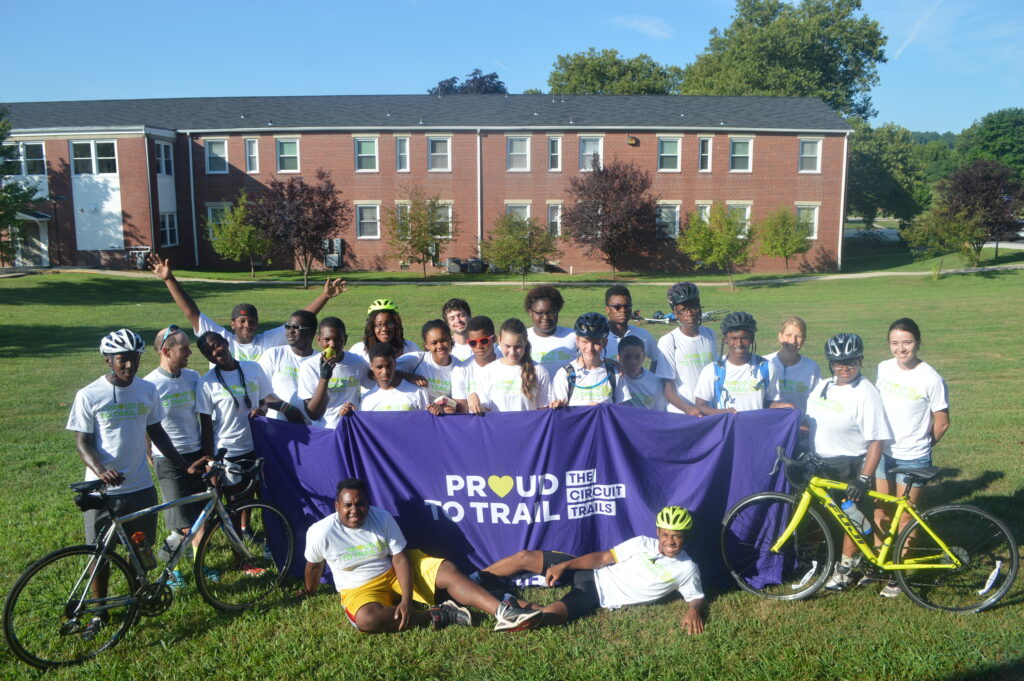Connectivity Evolution: Examining a Decade of Rails-to-Trails’ Impact, 2010–2020

By 2010, the rail-trail movement had taken hold across America—having gone from an idea in the 1960s to preserve precious transportation corridors, to a full-fledged national movement. From the historic railbanking statute and federal funding programs and innovations that helped spur more than 20,000 miles of rail-trails and new walk-bike infrastructure (by the early 2010s), to the development of cutting-edge research and programming, rail-trails had—in just a half century—become part of the fabric of American life.
But this momentum was just the beginning, as communities embraced these assets and recognized their power to deliver a range of benefits, including health, economic vitality, environmental sustainability, mobility, active transformation and social cohesion.
As the 2010s built momentum, opportunities to maximize the power of these essential community assets became clear, and a new focus took hold at Rails-to-Trails Conservancy (RTC) and across the movement: that of regional connectivity and the potential to connect the country by trail like never before.
Here’s a look at RTC and a decade of rail-trails—their power and their impact.
Turn of the Decade: Movement Heads to 20,000 Miles
By 2010, the movement was burgeoning; RTC had just donated more than 12,000 miles of GIS trail data to Google (in June 2009) and launched its three-year Urban Pathways Initiative bringing people together from more than 25 cities to share ideas and best practices on community-led trail programming and promotion.
Early 2010s: Regional Connectivity

By 2011, there were nearly 20,000 miles of rail-trails on the ground.
The year 2012 started off with a bang—including the release of comprehensive urban trail-use research and momentum for the developing 800-mile Circuit Trails Network, a premier model urban trail system and the first initiative included in RTC’s TrailNation™ portfolio as part of its evolving focus on regional trail connectivity.
Trails and active transportation infrastructure would take a hit in the 2012 federal transportation bill, but support in the previous decade and the growth of trails across the country—including more than 25,000 miles of known multiuse trails by October 2013—demonstrate the potential for further connectivity in regions across America … and nationally.
February 2011
RTC celebrates its 25th anniversary; the United States reaches nearly 20,000 miles of known rail-trails.
January 2012
RTC releases its Urban Pathways to Healthy Neighborhoods report—formed by input from trail developers in 25 cities and outlining best practices for promoting trail use in urban communities.
February 2012
RTC takes a lead role in the Circuit Coalition to help complete what is now an 800-mile regional trail system, creating crucial links in the Greater Philadelphia-Camden region to neighborhoods, business districts and natural areas. The trail system will help drive the regional trail economy, currently worth hundreds of millions of dollars annually.
June 29, 2012
MAP-21, Moving Ahead for Progress in the 21st Century Act, is signed into law, reducing federal investment in active transportation and consolidating three core programs from the previous transportation bill, including Transportation Enhancements, Safe Routes to School and the Recreational Trails Program, under a new Transportation Alternatives Program. RTC and its supporters continue to mobilize.
March 2013
RTC launches the first annual Opening Day for Trails, a national day of celebration for trails that welcomes collective and growing participation across the United States.
September 2013
RTC publishes “America’s Rails-with-Trails,” a defining study on the development of multiuse trails alongside active freight, passenger and tourist rail lines, and based on 20 years of data collection and analyses.
October 2013
25,000 miles of multiuse trails mapped on TrailLink—the country’s premier trail-finder database and mapping system.
2014: Connecting a TrailNation
The year 2014 would be one of innovation for the rail-trail community, as RTC and trail advocates recognized the need to demonstrate the transformative power of trail networks—for economic development, health, environmental sustainability, active transportation and social equity.
In an effort to create national models, RTC formally signed on to several major projects while strengthening its message to Congress on the importance of investing in these assets and bringing to the fore cutting-edge research for trail development.
In the summer of 2014, the exciting results of the five-year Nonmotorized Transportation Pilot Program—which sought to analyze how $25 million granted to four U.S. communities could spur new levels of active transportation—were announced … and then in the fall, the opportunity arose in Missouri to develop an epic cross-state trail system.
January 2014
RTC and partners in Wisconsin begin to develop an early vision for the Route of the Badger, initially slated to be a 500-miles-plus trail network, to create vital connections in the southeastern part of the state.
January 2014
RTC takes a leadership role in the Power of 32+, a regional trail project that eventually transforms into the Industrial Heartland Trails Coalition, which is working to create a regional trail network bridging dozens of counties in Ohio, Pennsylvania, West Virginia and New York, and spanning more than 1,500 miles. When complete, it will be the largest destination trail network in the country and help inject millions of new dollars of economic impact into local communities across the project footprint.
Feb. 11, 2014
RTC and the Partnership for Active Transportation develop the federal policy platform Safe Routes to Everywhere, calling on the federal government to increase its investment dedicated to active transportation and integrate health concerns into transportation decisions and policy.
June 2014
RTC launches T-MAP, the nation’s first nationwide survey of urban trail use, to create a new set of models for urban trail planning and development in America. One of the tools that emerges through this three-year project is BikeAble™—which goes on to serve as a powerful tool for analyzing connectivity for several major metropolitan areas of the country in the next half-decade.
June 2014
RTC takes the helm to create the Bay Area Trails Collaborative, a group of more than three-dozen diverse organizations dedicated to promoting policy, political and financial support for trails in California’s San Francisco Bay Area. When complete, the Bay Area regional trail network will connect nine counties and dozens of cities and communities.
July 2014
The results of the federally funded Nonmotorized Transportation Pilot Program are announced, revealing that investments in four communities—Columbia, Missouri; Marin County, California; Minneapolis–St. Paul, Minnesota; and Sheboygan County, Wisconsin—were responsible for averting 85.1 million vehicle miles traveled between 2009 and 2013.
August 2014
United States surpasses 21,000 miles of known rail-trails.
September 2014
RTC and partners in Missouri begin a statewide campaign to urge Ameren to railbank 144+ miles of the disused Rock Island Line for trail development. When complete, the trail would join with the Katy Trail and other trail segments to form a 450-mile cross-state loop linking Kansas City and St. Louis.
October 2014
RTC and partners in Wisconsin formerly launch the Route of the Badger, now a 700-miles-plus developing trail network in southeastern Wisconsin. A partnership between RTC and the Wisconsin Bike Fed, the trail network is expected to stretch from Milwaukee to Dousman and south from Sheboygan to Kenosha. Once the Badger’s south and west routes are completed, they will further link to trails that connect to Chicago, Madison and eventually Minneapolis.
2015–2017: Old Dreams, New Visions
As 2015 came to a close, RTC welcomed a new urban trail network to the fold: the 35-mile Baltimore Greenway Trails Coalition.
Then in 2016, the same year RTC launched the 800-mile Capital Trails Network, RTC began to revisit an early vision that first materialized in the late 1980s and served as an internal drumbeat for RTC for nearly three decades: a cross-country rail-trail.
By 2017’s end, RTC formally welcomed two more regional trail network projects into its purview—the 225-mile Miami LOOP in Miami-Dade County, and the 428-mile Caracara Trails in Texas’ Lower Rio Grande Valley—taking RTC’s comprehensive TrailNation portfolio to eight projects with a current combined mileage of nearly 7,200 miles.
November 2015
In collaboration with partners in Baltimore, RTC formally launches the Baltimore Greenway Trails Coalition, which is creating a 35-mile world-class urban trail network that will eventually connect dozens of historically disconnected neighborhoods in Baltimore City.
December 2015
RTC members and supporters help defend funding for trails and walk-bike infrastructure in the FAST Act, the new federal transportation bill, signed into law on Dec. 4.
February 2016
RTC celebrates its 30th anniversary; there are more than 22,000 miles of known rail-trails in the United States.
Summer 2016
After early analysis of rail-trail development through to 2016, RTC confirms the viability of a cross-country rail-trail, first envisioned by co-founder David Burwell in the late 1980s. RTC staff travel to Wyoming and Montana to explore route solutions in the west.
October 2016
RTC, along with the Washington Area Bicyclist Association, National Park Service and REI, launch the Capital Trails Coalition, which currently includes more than 800 miles of existing and planned trails and connections in Maryland, Washington, D.C., and Virginia.
December 2016
A 47.5-mile portion of trail built along the disused Rock Island Line—known as the Rock Island Spur of Katy Trail State Park—opens in Missouri.
Winter 2017
Preliminary GIS analyses reveal multiple potential cross-country route options between Washington, D.C., and Washington State that are more than 50 percent complete.
Spring 2017
RTC joins a group of partners in Texas to help lead implementation of the Lower Rio Grande Valley Active Plan—now the Caracara Trails—a 428-mile trail network project intended to unify the Valley’s natural and geographic resources and achieve major health and economic development goals in the region.
Summer 2017
RTC, the Missouri Rock Island Trail, Inc. and Wisconsin Bike Fed mobilize thousands of people to submit comments to the state of Missouri in favor of the planned 144-mile Rock Island Trail and rally hundreds of residents and public leaders at the Missouri State Capitol to show their support for the pathway and potential tourism generator, which connects 23 communities.
Fall 2017
RTC partners with the Miami-Dade Trail Alliance in Florida to create the Miami LOOP. The goals of the 225-mile trail network include expanding transportation options, making walking and biking safer and more equitable, strengthening the economy, reducing the carbon footprint and improving health and wellness across Miami-Dade County.
2018–2019: Connecting a Nation by Trail
With a cross-country route assessment for the Great American Rail-Trail under way, the organization continued to build momentum for critical projects and nationwide connectivity for trails and active transportation throughout its TrailNation portfolio. RTC also launched a new campaign in advance of the next transportation bill to urge Congress to adopt a visionary policy that invests in connected trails and walk-bike infrastructure between communities and states.
In 2019—RTC formally launched the Great American Rail-Trail gateway trails and full 3,700-miles-plus preferred route in January and May respectively, solidifying the organization’s vision to connect America by trail, regionally and nationally, and bring the transformative benefits of trails to communities across the country. RTC also presented the results of its Active Transportation Transforms America study, which presents proof of the massive transformative impact connected active-transportation infrastructure could have on the country—to the potential tune of $138 billion annually.
In December 2019, RTC ended a major year and defining decade in celebration with Missouri’s announcement of an interim trail use agreement with Missouri Central Railroad Company (a subsidiary of Ameren) for the Rock Island Trail—marking a major and historic step forward toward railbanking the corridor and transforming it into a community walking and bicycling asset for tourism, health and active transportation.
January 2018
As the debate surrounding a federal transportation bill heats up, RTC launches a national campaign to ensure trails and walking and bicycling networks are included in federal infrastructure legislation—specifically calling for an increase in investments to support connectivity at the local level, and between communities and states.
February 2018
RTC begins a formal route assessment across 12 states and the District of Columbia—which includes meeting with hundreds of state and local officials and trail managers, and collecting mapping data and information for 130 trails—to establish to establish a preferred route for the Great American Rail-Trail.
September 2018
TrailLink reaches more than 4,100 rail-trails and multiuse trails mapped extending an estimated 35,000 miles.
January 2019
RTC announces the gateway trails for the Great American Rail-Trail, which span 12 states—Maryland, Pennsylvania, West Virginia, Ohio, Indiana, Illinois, Iowa, Nebraska, Wyoming, Montana, Idaho and Washington—as well as the District of Columbia.
May 2019
RTC, in partnership with hundreds of communities and organizations, launches the full preferred route of the Great American Rail-Trail, which—more than 52 percent complete (as of 2019) and connecting Washington, D.C., and Washington State—will span more than 3,700 miles and unite an estimated 50 million people within 50 miles of the route.
October 2019
RTC launches a new national study, “Active Transportation Transforms America,” which shows that the potential annual return on investment of connected active-transportation infrastructure—currently producing an estimated combined health, climate and economic return of $34 billion—could be as high as $73 billion+ in a modest increase scenario and $138 billion+ in a substantial increase scenario.
December 2019
After a five-year advocacy effort for the Rock Island Trail involving more than 30,000 public comments in favor, the Missouri Department of Natural Resources announces they have signed an interim trail use agreement with Missouri Central Railroad Company (a subsidiary of Ameren), marking a major and historic step forward toward railbanking the corridor and transforming it into a recreation, active transportation and tourism asset for nearly two dozen communities.
Related: Explore our interactive timeline of the history of RTC.

Donate
Everyone deserves access to safe ways to walk, bike, and be active outdoors.
